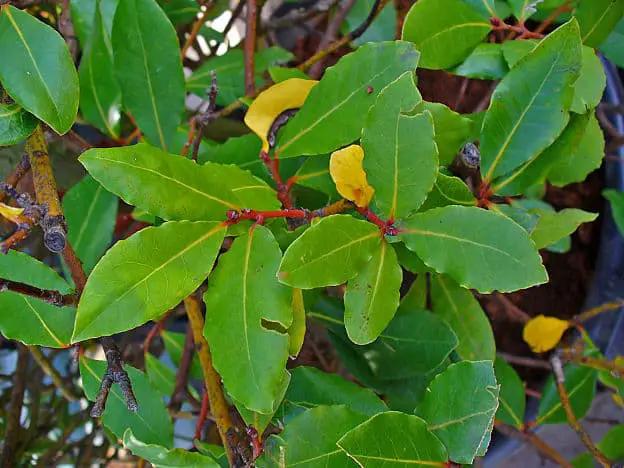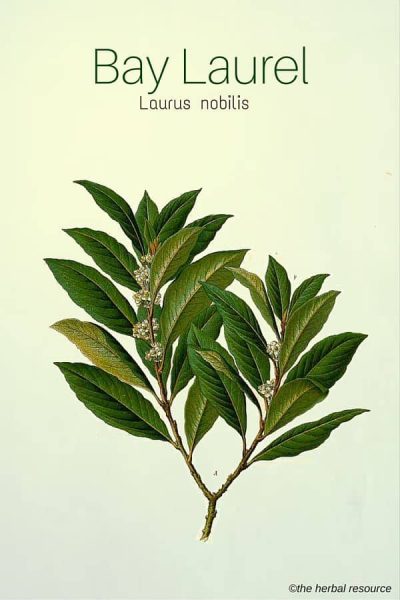Botanical Name: Laurus nobilis.
Other Common Names: Bay, Bayleaf, Bayleaf laurel, Laurel, Grecian laurel, True laurel, Sweet laurel, Sweet bay, Laurbær (Danish), Lor (German), Laurier (French), Yue gui (Chinese), Lárvidarlauf (Icelandic)
Habitat
Bay laurel is native to the eastern Mediterranean and the east coast of the Black Sea.
The plant has been cultivated for centuries and now grows wild throughout the Mediterranean.
Today, bay laurel is cultivated in southern and western Europe, including England.
The tree thrives best in a warm coastal climate. However, growing bay laurel in containers is not difficult and it has not high demands when it comes to soil composition.
It can be kept outdoors during the summer months but should be moved inside during winter as it can not tolerate frost.
Description
Bay laurel is an evergreen tree or shrub that belongs to the laurel family (Lauraceae).
Normally, it can grow up to 2-5 meters (7 to 16 feet) in height but under very favorable conditions it has been known to reach up to 20 meters (66 feet).
The bark is smooth and reddish-brown and the leaves are lanceolate and leathery with shiny upper sides and matted undersides. They have a pleasant smell and a bitter taste.
The flowers sitting in the leaf axils are fragrant, star-shaped and yellow-white. They are either male or female located on separate plants.
The fruit is a drupe the size of a small grape or cherry containing one seed. It is black-blue when ripe and has a sharp flavor.
Plant Parts Used
The leaves, essential oil and very rarely the fruit. The leaves and fruits are used for their aromatic qualities.
The leaves should be picked from two-year-old or more plants. They should be handpicked early in the day and then laid out to dry with something on top that gives light pressure to avoid curling.
The leaves should not be dried in the sun because they will lose flavor and turn brown.
Dried bay laurel leaves should be bright green, whole and pliable and should be stored in a container with a tight-fitting lid, kept in a dark place. The leaves should not be stored for more than one year.
Fresh leaves can also be used but for many, the taste is too bitter.
The essential oil is extracted from the bay laurel leaves by steam distillation.
The oil has a herbaceous and spicy scent and comes in numerous variations.
For example, the oil produced in North Africa has an aroma reminiscent of eucalyptus due to the high content of cineol while the oil produced in Italy or France has a lower cineol content resulting in an aroma most people associate with the laurel leaves used in cooking.

Common Therapeutic Uses, Benefits and Claims of Bay Laurel
Active Ingredient and Substances
The main ingredients of the essential oil are eucalyptol, eugenol, linalool, geraniol, and alpha-pinene.
The leaves contain sesquiterpenes, lignan glycosides, alkaloids, mucins, bitter substances, tannins, and resins. (1)
Bay Laurel in Mythology
According to Greek mythology, the female nymph Daphne was transformed into a laurel tree by her father the river god Ladon to save her from the unwanted affections of the god Apollo. Hence, the bay laurel tree is often associated with Apollo.
Bay laurel was also known to be used in rituals by the Delphic oracle, a name given to of any priestess of the temple of Apollo at Delphi.
Because large doses of bay laurel leaves can have a narcotic effect it might explain why the herb was used in these rituals.
In ancient times it was believed that the bay laurel tree held magical powers, warding off evil witchcraft and disease.
The Greeks considered it as a medicine that could protect against diseases, especially against the plague and it was often devoted to Asclepios, the son of Apollo and the god of medicine.
Both the ancient Greeks and Romans considered wreaths made of bay laurel leaves as a symbol of victory and high status. (2)

Medicinal Uses of Bay Laurel in the Past
Bay laurel was not only used in ceremonies and rituals in the past but also as herbal medicine. Hippocrates used all parts of the plant as a remedy for a variety of ailments, both internally and externally.
In medieval times, the herb’s medicinal uses for ailments such as stomach problems, colic, and renal diseases were recorded by monks in handwritten medical books.
Internal Uses
Today, bay laurel is mostly used as a pain remedy for thematic conditions and against ailments related to the upper part of the digestive tract.
The herb is also used for flu, bronchitis and to stimulate appetite by increasing the secretion of digestive fluids.
Extract of the leaves has been used to initiate menstruation and the fruits were once used to induce abortion. (3)
Bay laurel contains substances known to relieve pain associated with migraine.
Why the herb has this pain relieving properties has not been clarified but it might be due to some substances in the herb that release serotonin from the blood platelets. (1)
External Uses
Bay laurel leaves have been used externally as a compress on bruises and sprains and as a remedy for dandruff.
Bay laurel has insect repellent properties, and the dried leaves can be used in potpourris in order to keep insects at bay. (4)
The Essential Oil
The essential oil of bay laurel can be used in aromatherapy, but it’s not widely used because it can cause skin irritation.
When it is used in aromatherapy, it is often mixed with oils from coriander, eucalyptus, ginger, juniper, lavender, rose, rosemary, thyme, and ylang-ylang.
If it is highly diluted in a carrier oil, it may be rubbed into the skin as a remedy for rheumatic ailments, aching muscles and joints, sprains and scraped the skin.
The oil is also considered to have a positive effect on the lymphatic system, to be a good tonic for the hair, stimulate hair growth and remove dandruff.
The essential oil is often used to treat conditions related to the respiratory system, such as a resistant cough and bronchitis, often combined with eucalyptus essential oil.
The oil is thought to be good for the digestive system, liver, and kidneys and to increase appetite. It might also be useful in removing intestinal gas and for abdominal pain. (4)
The essential oil is used as an ingredient in commercial products like solvents, cosmetics, toiletries and perfumes, particularly men’s aftershave.
Culinary Uses
Bay laurel (both leaves and the essential oil) is widely used as a spice and flavor in the food industry.
The dried leaves are used as a seasoning for pies, soups, sauces, marinades, stews, and pickles.
The leaves are used as an ingredient in many spice mixtures, like the famous French “bouquet garnii”, although there is no generic recipe for bouquet garni, it usually includes thyme and bay laurel leaf.
The leaves should be used sparingly in cooking and from the start as they emit taste slowly.
Therapeutic Dosages
The essential oil (3%) should be diluted in a carrier oil ( vegetable oil).
When bay laurel is intended as medicine, a trained and licensed herbalist or other knowledgeable healthcare providers should be consulted both regarding the correct dosage and to see if the herb is suitable. (1)
Side Effects and Interactions of Bay Laurel
Bay laurel leaves for cooking are considered safe. The essential oil should always be used with great caution, and never internally.
The oil has a very mild narcotic effect. When the herb is used in aromatherapy, the oil must always be used in a heavily diluted form (max 3%).
The essential oil should not be used by pregnant or breastfeeding women or by children.
It’s important not to confuse bay laurel with plants with similar names and appearance.
This applies in particular to cherry laurel (Prunus laurocerasus) which has leaves that are highly toxic and are quite similar to bay laurel. (1)
Supporting Reference – Online
- Mansour, Oussama & Darwish, Manal & Ismail, Ghenwa & Al-Abideen Douba, Zein & Ismaeel, Ali & Sabee Eldair, Kamel. (2018). Review Study on the Physiological Properties and Chemical Composition of the Laurus nobilis. 5.
- Nelson, Jennifer Schultz; Bay Laurel – Plant Palette. The University of Illinois.
- EL MALTI, J. and AMAROUCH, H. (2009), ANTIBACTERIAL EFFECT, HISTOLOGICAL IMPACT AND OXIDATIVE STRESS STUDIES FROM LAURUS NOBILIS EXTRACT. Journal of Food Quality, 32: 190-208. doi:10.1111/j.1745-4557.2009.00245.x
- Sahin Basak, S., & Candan, F. (2013). Effect of Laurus nobilis L. Essential Oil and its Main Components on α-glucosidase and Reactive Oxygen Species Scavenging Activity. Iranian journal of pharmaceutical research : IJPR, 12(2), 367–379.
Supporting References – Offline
Bown, Deni: The Royal Horticultural Society New Encyclopedia of Herbs & Their Uses. London, Dorling Kindersley 2002.
Lawless, Julia: The Illustrated Encyclopedia of Essential Oils. Shaftesbury, Element Books 1995.
Price, Shirley & Len Price: Aromatherapy for Health Professionals. Philadelphia, Elsevier Ltd. 2007.
Reader’s Digest: Nature’s Medicine Chest. London, Reader’s Digest 1997 (1999).
Schnaubelt, Kurt: Advanced Aromatherapy. The Science of Essential Oil Therapy. Rochester, Vermont, Healing Arts Press 1998.
Sellar, Wanda: The Directory of Essential Oils. London, Vermilion 2005.
van Wyk, Ben-Erik & Michael Wink: Medicinal Plants of the World. Portland, Oregon, Timber Press 2004.
Williamson, Elisabeth M.: Potter’s Herbal Cyclopaedia. Essex, Saffron Walden 2003.
Thordur Sturluson
Latest posts by Thordur Sturluson (see all)
- What is the Difference Between Hemp and Marijuana? - June 3, 2019

It also makes makes great tea
Yes, I use it both for cooking and for flus in the winter. Overwinters here very easily in zone 8-9 outside.
Portland, OR